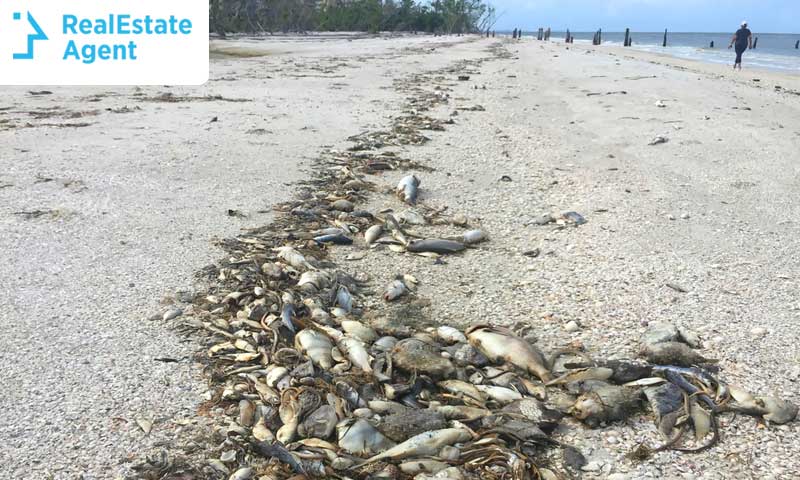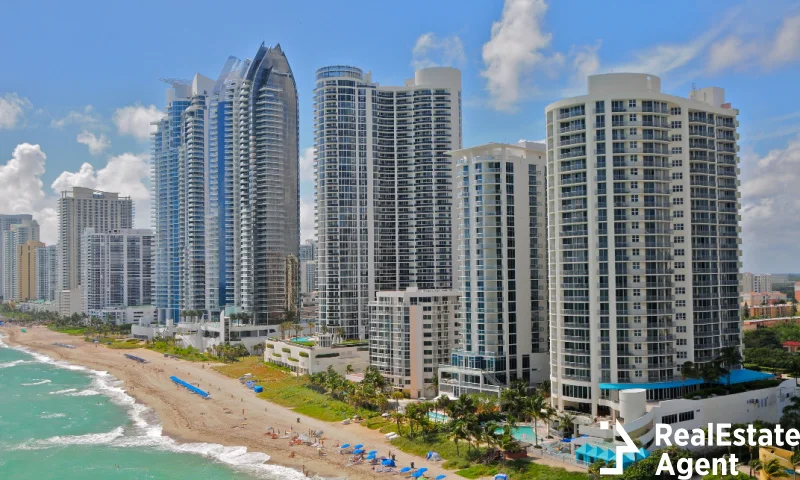You’ve probably seen it in the news that, back in August, the state of Florida had declared a state of emergency for 7 counties along the Gulf of Mexico coast because of the phenomenon popularly called “Red tide”. We have put the term between quote marks because scientists have been phasing out of its usage since red tides are not always actually red-colored and tides are unrelated to the occurrence of said phenomenon, however, the effects of red tide are very real and related to several possible troubles to real estate. And considering that, with Category 4 Hurricane Michael striking the Florida Panhandle exactly from the Gulf of Mexico, and the big water surge that is expected, the red tide might as well advance into the mainland further damaging the people of Florida and its real estate.
Now in 2019, the red tide is back. Once again, Florida’s beaches are choked with the carcasses of dead aquatic life, as deadly algae takes its toll. So what exactly causes the red tide, and how can it be combatted? Let’s find out.
What is a Red Tide and what does it mean?
 When large concentrations of certain aquatic microorganisms (algae) blossom, they release photosynthetic pigments into the water, making it look colored by shades of red that go from rust to blood red. This aspect is what’s called red tide. However, if it ended there, it would be fine and kind of cool. Would render a lot of instagram pictures and horror movie shots, right?
When large concentrations of certain aquatic microorganisms (algae) blossom, they release photosynthetic pigments into the water, making it look colored by shades of red that go from rust to blood red. This aspect is what’s called red tide. However, if it ended there, it would be fine and kind of cool. Would render a lot of instagram pictures and horror movie shots, right?
The problem with red tides is that the concentration of this algae is bad. Also known as “HAB”, an acronym for Harmful Algal Blooms, red tide algae produce harmful toxins that can kill marine life and is harmful to humans. Regarding the marine life, the worst red tide effects are the contamination of shellfish.
Here’s what happens: some shellfish like clams, mollusks, and oysters store the toxins produced by the algae in their fatty tissue and concentrate saxitoxin, which blocks sodium channels. When animals – not only fish but diving ducks and even birds – ingest the toxins from those algae, it can cause a poisoning paralysis within 30 minutes. And the toxin stays stored on dead fish, so once they rise to the surface, other birds can end up eating them and also dying. So, you see, the red tide effects come in cascades and can be very damaging to the environment.
Now, when it comes to humans, the red tide effects are indirect but also direct. The indirect is, of course, through the ingestion of contaminated shellfish, but humans get directly harmed by the red tide effects through skin contact and also by breathing in “brevetoxins” produced by the harmful algal bloom. Red tide symptoms in humans include respiratory irritation, bronchoconstriction, coughing and wheezing – due to the breathing in of brevetoxins – skin irritation in the case of skin contact, and, in the case of ingestion, drowsiness, diarrhea, nausea, loss of motor control, tingling, numbing or aching of extremities, incoherence and respiratory paralysis. Quite a lot of red tide symptoms, huh?
So, I guess we covered what is red tide. But this is not a scientific blog, so let’s talk about the red tide effects on real estate, specifically Florida, because that’s our neck of the woods; our bread and butter.
How do you fight the Red Tide?
But what exactly can be done to combat the red tide, you might ask? Scientists use a variety of ways to combat the toxin-spewing algae that makes up the red tide. One of the most proven ways is the use of compounds composed of non-harmful parasitic algae, seaweed and filter-feeding organisms that attack the harmful algae of the red tide.
These compounds, when tested in massive simulation tanks, were shown to eliminate the toxic algae in relatively short periods of time, without damaging the water chemistry or doing further harm to aquatic life. There are other possible solutions, from copper sulfate compounds to specially built structures covered with filter feeding organisms, but none are proven to have a one hundred percent success rate.
The Red Tide in Florida
 Poor Florida. When it comes to natural disasters, it just can’t catch a break. If it wasn’t enough to have several cities within our worst cities for natural disasters list, here is the sunshine state again, making the news regarding a natural disaster occurrence. But, truth be told, the occurrence of Red Tides in Florida is nothing new; the first documented occurrence dates back to 1844 at the same Gulf coast. In fact, not even THIS specific red tide occurrence is new; it’s believed to have started a month after Hurricane Irma ravaged the Gulf in September 2017!
Poor Florida. When it comes to natural disasters, it just can’t catch a break. If it wasn’t enough to have several cities within our worst cities for natural disasters list, here is the sunshine state again, making the news regarding a natural disaster occurrence. But, truth be told, the occurrence of Red Tides in Florida is nothing new; the first documented occurrence dates back to 1844 at the same Gulf coast. In fact, not even THIS specific red tide occurrence is new; it’s believed to have started a month after Hurricane Irma ravaged the Gulf in September 2017!
For a number of reasons, though, the red tide in Florida was being kept under wraps. Partly because Irma’s damages were still being dealt with and demanded a lot of time, money and attention, partly because, just like in the movie Jaws, this natural disaster has unpleasant effects on the economy. Remember Jaws? At the beginning of the movie, a couple gets attacked on the shores of the fictitious Amity Island and the sheriff feels the beach needs to be closed so no one else dies. But the greed of local business owners makes the mayor keep the beach open; they’re days away from summer when tourists flock to the city to enjoy the beach and everyone in town makes a lot of money off of that. The rest of the story everyone knows; the shark ravages the beach and kills a lot of people until the sheriff finally kills it.
Okay, now replace the shark with the red tide effects. In August, the red tide map of Florida started at the end of the Everglades and went all the way until Tampa, so these harmful algal blooms damaged not only tourism but real estate as a whole in many ways. Think of someone that, knowing that Tampa is one of the best cities to invest in real estate, decided to buy a house near the bay to do some airbnb renting. Hurricane Irma has probably damaged his/her house, but, assuming he/she is smart, he probably had insurance against an Act of God like this. Now, with the red tide in the news, he/she would not be able to recover the damages through renting, because who would want to get a sore throat from breathing the breeze coming through the ocean? And what about the local fishermen and local restaurants? How do they keep their business afloat when all of a sudden there’s doubt regarding their moneymaker’s safety?
But, with gubernatorial elections coming, and insurmountable evidence of red tide symptoms – a huge shark whale appeared dead at Sanibel Island close to Cape Coral, 287 sea turtles have died since October, hospitals within the area had a 50% increase of patients with respiratory problems and other red tide symptoms… – it became impossible not to address the problem. Things got even worse in September when it was revealed that the other coast of Florida was also suffering from it, and from Palm Beach to the north, beaches were shortly interdicted because of small red tide occurrences.
Besides the state of emergency, financial aid of $1.5 million was also announced to diminish the red tide effects and make sure the algae epidemic is contained. There’s no plan beyond containing, as scientists don’t recommend killing the algae because the effects on the environment might be worse than letting the phenomenon going on. Typically, during winter, because of the lack of rain and increasing wind, the proliferation of algae dies or dissipates, the environment balances itself and things get back to normal.
And then, when things seemed to be slowing down, it came…
Hurricane Michael
 The Category 4 Hurricane Michael that’s scheduled to make landfall Wednesday, October 10 has basically morphed from Tropical Storm to Hurricane between the northeastern part of Cuba and the Mexican Gulf. It quickly escalated, surprising even seasoned meteorologists, because of the hot waters of the Gulf, and – as we noted before – those waters are still filled with active Harmful Algal Blooms.
The Category 4 Hurricane Michael that’s scheduled to make landfall Wednesday, October 10 has basically morphed from Tropical Storm to Hurricane between the northeastern part of Cuba and the Mexican Gulf. It quickly escalated, surprising even seasoned meteorologists, because of the hot waters of the Gulf, and – as we noted before – those waters are still filled with active Harmful Algal Blooms.
It’s yet to be seen how will this translate. Will Hurricane Michael flood the Florida Panhandle and push the red tide inland adding an extra threat to Floridians that now will have to add “O2 face mask” to their hurricane tips for hurricane season book? Maybe it’s the opposite and the winds will be so strong that it will disrupt the algae system and end the red tide threat altogether? Or maybe it will only push the red tide away from Florida without killing it, just moving its nuisance and health hazards to another state?
We’re yet to discover but for now, after a tough summer for real estate within the Florida red tide map – especially for vacation rentals with a lot of last-minute cancellations on the heels of Irma’s aftermath – the Hurricane Michael and Red Tide in Florida combo promises to take its toll on the population of the cities along the Florida Panhandle. A good opportunity for Acts of God House Flipper Investing? Looking at the bright side of it, yes. But a tough time for longtime residents, especially the ones who rely on tourism in any form.
If the financial aid and the environmental conditions do help and stop the red tide altogether, it won’t be that horrible – only a slow down on the increasingly rising prices of that whole area within the red tide map. But if it doesn’t, if – like the sharks in Jaws – the red tide has several sequels no one wants to see… then it really becomes a horror movie for the people of Florida; with decreasing home prices and all last decade’s infrastructure and tourism efforts put to trash.
The Red Tide in 2019
Now, in 2019, Florida is experiencing another devastating red tide. Starting as far back as mid 2017, waves of the toxic algae that cause red tides have left thousands of dead fish rotting on Florida’s beaches, driving away leisure-seekers with its horrible stench.
Scientists are researching ways to alleviate the effects of the red tide, and the state government is dedicating state resources to fight the phenomena. After Florida state governor Ron Desantis led an initiative known as the Red Tide Task Force, scientists and state employees managed to curb the tide of toxic algae. The effort to fight the red tide ended after roughly sixteen months of intensive environmental preservation efforts, costing the state government millions and doing heavy damage to the economy.
Unfortunately, in recent months, the red tide has experienced a resurgence. Once again, the corpses of dead aquatic life are washing up onto the shores of south Florida, making the beaches intolerably foul and doing heavy damage to local businesses and even to the real estate market.
Where is the Red Tide occurring now?
At the moment, the red tide is mostly localized to areas of sea adjacent to Sarasota, Collier Charlotte and Lee counties. Unfortunately, the red tide is slowly but steadily creeping north towards Tampa threatening the local businesses and even the real estate market, as some of our real estate agents in Tampa have revealed to us.
So far, this red tide has already had a marked effect on the economy of Sarasota county and its neighboring counties and real estate agents in Sarasota are afraid that the red tide will have an impact on the home prices and the cost of rent. These areas still haven’t recovered from the previous 2017-2018 red tide, and the current red tide is doing even more damage to an already damaged economy.
Luckily, the Florida state government is working to fight the negative effects of the red tide. In June 2019, the governor of Florida signed into a law a bill focused on providing state sponsored marine biologists with the funding they need to study and find possible solutions for the red tide. Over the course of six years, this bill will provide marine biologists with over 18 million dollars that will be used to devise ways to combat the red tide.









I do trust all the concepts you’ve offered on your post.
They are really convincing and can definitely work. Nonetheless, the posts are too quick
for novices. May you please lengthen them a bit from next time?
Thank you for the post.
Hi! We will take your advice into consideration in our future blogs. We are glad to have you among our readers.